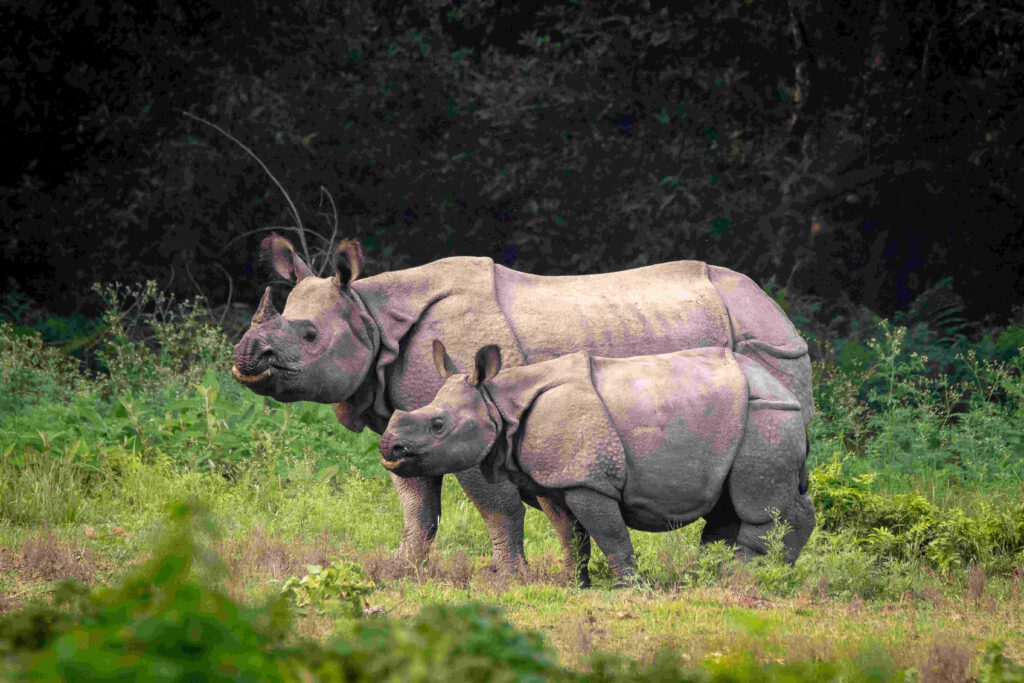Rhinoceroses, often called rhinos, are among our planet’s most iconic and awe-inspiring creatures. Their sheer size, prehistoric appearance, and remarkable adaptations have captivated the imagination for centuries. These magnificent animals are an integral part of Earth’s biodiversity and a symbol of conservation efforts worldwide. In this blog, we’ll delve into the fascinating world of rhinoceroses, exploring their biology, behavior, conservation status, and challenges in the modern world.

Aditya Pal, CC BY-SA 4.0 https://creativecommons.org/licenses/by-sa/4.0, via Wikimedia Commons
I. Rhino Species
Rhinoceroses belong to the family Rhinocerotidae and are divided into five distinct species, each with its own unique characteristics:
1.White Rhinoceros (Ceratotherium simum): Despite the misleading name (which is thought to be a mistranslation of “wide” referring to the shape of its mouth), the white rhino is primarily gray. They are the largest of the five species and can weigh up to 2,300 kilograms. White rhinos are known for their relatively gentle disposition and are characterized by a squared upper lip adapted for grazing.
2. Black Rhinoceros (Diceros bicornis): Black rhinos are gray, smaller, and more aggressive than their white counterparts. Their upper lip is pointed and adapted for browsing on leaves and twigs. Unfortunately, they are critically endangered, primarily due to poaching for their horns.
3.Indian Rhinoceros (Rhinoceros unicornis): As the name suggests, these rhinos are native to the Indian subcontinent. They are characterized by their thick, folded skin and a single horn on their snout. Indian rhinos are primarily herbivores and inhabit grasslands and swamps.
4.Javan Rhinoceros (Rhinoceros sondaicus): The Javan rhino is one of Earth’s rarest and most endangered large mammals. They are small, with a single horn, and are found in dense tropical forests in Southeast Asia.
5. Sumatran Rhinoceros (Dicerorhinus sumatrensis): This is another critically endangered species, the smallest of the rhinos. Sumatran rhinos are covered in coarse hair and have two horns. They are also native to Southeast Asia.
II. Anatomy and Adaptations
Rhinoceroses are well-adapted to their environments, displaying several unique features and adaptations:
- Horns: Rhinos are famous for their horns, which are made of keratin, the same material as human hair and nails. These horns can grow up to several feet long and are used for various purposes, including defense, digging, and marking territory.
- Thick Skin: Their skin is incredibly dense and can be up to 2 inches in some places. It acts as armor against predators and helps regulate body temperature by retaining moisture.
- Size and Strength: Rhinoceroses are massive animals with a robust build. Their sheer size makes them formidable creatures, and they have a reputation for being able to charge at impressive speeds when threatened.
- Solitary Nature: Rhinos are typically solitary animals, and their territorial behavior helps ensure they have access to sufficient food and water resources.
III. Behavior and Lifestyle
Rhinoceroses exhibit a range of behaviors that are both fascinating and critical to their survival:
- Solitary Living: As mentioned earlier, rhinos are generally solitary animals. They establish territories and communicate with one another through vocalizations, dung heaps, and scent marking.
- Diet: While white rhinos are grazers, black rhinos are browsers, and their diets contain different plant materials. Rhinos have a selective palate and can be pretty picky about their food.
- Mating and Reproduction: Rhinoceroses typically have a gestation period of around 15-16 months and give birth to a single calf. Mothers protect their offspring, and the calf stays with its mother for several years.
IV. Conservation Challenges
Despite their resilience and adaptations, rhinoceroses face numerous threats that have led to a decline in their populations:
- Poaching: The illegal trade in rhino horns, driven by demand in some Asian countries, has been the most significant threat to their survival. Poachers kill rhinos for their horns, which are believed to have medicinal properties, although no scientific evidence supports these claims.
- Habitat Loss: As human populations expand and forests are cleared for agriculture and development, rhinos lose their natural habitat. This fragmentation can isolate populations and lead to genetic issues.
- Climate Change: Changing weather patterns, including droughts and floods, can affect rhino habitats and food sources.
V. Conservation Efforts
Thankfully, there are ongoing efforts to conserve and protect rhinoceros populations:
- Anti-Poaching Measures: Many organizations and governments have invested in anti-poaching units to protect rhinos from illegal hunting.
- Habitat Preservation: Conservationists work to establish and maintain protected areas and wildlife reserves to safeguard rhino habitats.
- Community Engagement: Engaging local communities in conservation efforts can reduce poaching and provide economic alternatives to activities that harm rhinos.
- Breeding Programs: Captive breeding programs are in place to boost rhino populations, especially for the critically endangered species like the black rhino and Javan rhino.
VI. Conclusion
Rhinoceroses are truly magnificent creatures that have roamed the Earth for millions of years. Their size, strength, and unique adaptations make them a testament to the wonders of the natural world. However, they are also under grave threat due to poaching and habitat loss, making conservation efforts critical to their survival. By supporting these efforts and raising awareness about the plight of rhinos, we can help ensure that these majestic animals continue to roam our planet for generations to come.

